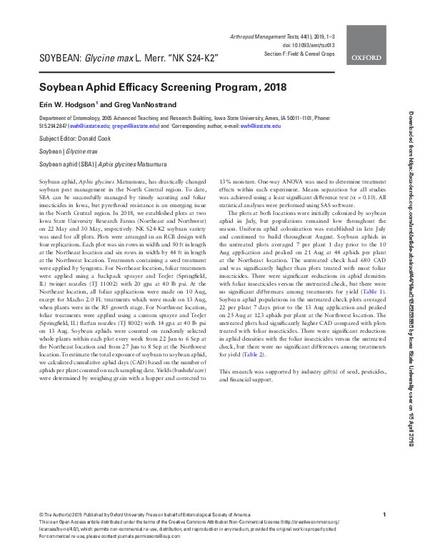
Soybean aphid, Aphis glycines Matsumura, has drastically changed soybean pest management in the North Central region. To date, SBA can be successfully managed by timely scouting and foliar insecticides in Iowa, but pyrethroid resistance is an emerging issue in the North Central region. In 2018, we established plots at two Iowa State University Research Farms (Northeast and Northwest) on 22 May and 30 May, respectively. NK S24-K2 soybean variety was used for all plots. Plots were arranged in an RCB design with four replications. Each plot was six rows in width and 50 ft in length at the Northeast location and six rows in width by 44 ft in length at the Northwest location. Treatments containing a seed treatment were applied by Syngenta. For Northeast location, foliar treatments were applied using a backpack sprayer and TeeJet (Springfield, IL) twinjet nozzles (TJ 11002) with 20 gpa at 40 lb psi. At the Northeast location, all foliar applications were made on 10 Aug, except for Macho 2.0 FL treatments which were made on 13 Aug, when plants were in the R5 growth stage. For Northwest location, foliar treatments were applied using a custom sprayer and TeeJet (Springfield, IL) flatfan nozzles (TJ 8002) with 14 gpa at 40 lb psi on 13 Aug. Soybean aphids were counted on randomly selected whole plants within each plot every week from 22 Jun to 6 Sep at the Northeast location and from 27 Jun to 8 Sep at the Northwest location. To estimate the total exposure of soybean to soybean aphid, we calculated cumulative aphid days (CAD) based on the number of aphids per plant counted on each sampling date. Yields (bushels/acre) were determined by weighing grain with a hopper and corrected to 13% moisture. One-way ANOVA was used to determine treatment effects within each experiment. Means separation for all studies was achieved using a least significant difference test (α = 0.10). All statistical analyses were performed using SAS software.
Available at: http://works.bepress.com/erin_hodgson/318/

This article is published as Hodgson, E. W., and G VanNostrand. Soybean Aphid Efficacy Screening Program, 2018. Arthropod Management Tests 44 (2019): tsz013. doi: 10.1093/amt/tsz013.